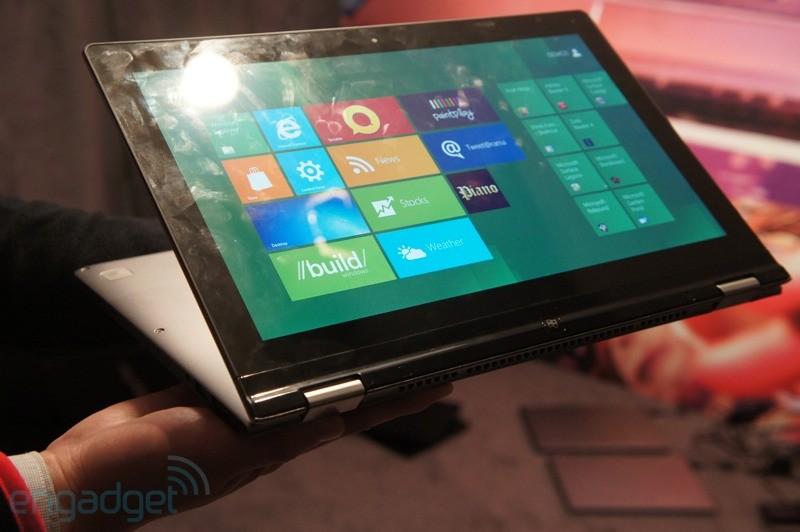
Going in to CES this year, we imagined we would see a plethora of tablets on the show floor – announcements, release dates, display models, etc. In truth, we only officially saw a handful of tablets get made official, and there was light talk of upcoming Windows 8 tablets. To put it frankly, it was a bit of a letdown, especially for those of us who were really hoping to see a surplus of new tabs.
That said, all hope is not lost for tablets in 2012. Some speculate that companies have gone beyond CES as a primary vehicle for launching and announcing new devices. Microsoft announced that this is their last CES keynote (for now, at least) and many believe that it serves as a testament to the show's waning significance.
What's really important, though, is not the gravity of the show, what we got some hands-on time with or even what was announced at CES. It's what was hinted by manufacturers that truly matters – concepts and the assumed direction of new entries.
Toshiba came forth with a few surprises of their own. They announced the Excite X10, which is nothing terribly special. It's just another Android tablet with the now-standard specifications. Oh, and it's super thin. But at their booth, they had a couple concept tablets on display, and that's where things get a bit juicy.
First up was the 13.3-inch tablet. There were no specs given, but the sheer size of this thing was enough to stop me in my tracks. Of course, there are some things that it would have to have in tow – like a super high resolution display, quad-core processor (to push those pixels), etc. – to really make me weak at the knees. The second tablet was a 5.1-inch tablet. Normally, nothing about a 5.1-inch slab would grab my attention; I would rather have a Galaxy Note, which rides the thin line between phone and tablet. But the unique attribute of the 5.1-inch slab from Toshiba is the 21:9 aspect ratio. Personally, I'm not very fond of the true widescreen display. But the point here is differentiation and the reality of varying aspect ratios in tablets. You may recall that a colleague of mine over at TechRepublic isn't very fond of the 16:9 aspect ratio reference design in Honeycomb and ICS tablets. However, the fact that Toshiba is willing to stray from the path a bit means that if you don't like the standard 16:9 of your run-of-the-mill Android tablet, you may have options in the future.
But Toshiba isn't the only one willing to think outside the box. From the very beginning of the big Honeycomb tablet push by Android OEMs, I've kept my eye on everything ASUS has done. Any little peep from their neck of the woods and I'm all ears. I bought their Eee Pad Transformer the day it went live for pre-order on Amazon and have struggled quite a bit while trying to talk myself out of buying a Transformer Prime.
Lenovo, too, has been taking the simplistic tablet concept and applying it in more ... useful ways. First, they had a pre-CES announcement of the IdeaTab S2. Again, the S2 is another typical Android tablet. Like the Transformer and Transformer Prime, though, it has a keyboard dock companion, too.

However, the true meat to all of this, surprisingly, lies with Windows 8. I've had my eye on Windows 8 tablets since we were shown the first preview in mid-2011. The first Win8 tablets are expected in the next several months and what makes a Windows tablet more appealing or viable is the fact that they tout a full-fledged operating system versus half-functional tablets with mobile platforms. Probably the most exciting thing of CES tablet-wise was Lenovo's IdeaPad Yoga (which I did not see until I had already left Vegas, and it's killing me that I didn't get any hands-on with it).
When you first open the IdeaPad Yoga, it will look like any other Windows 8 laptop. But the key difference is in the hinge and the fact that it comes with a touchscreen display. Instead of your typical laptop hinge, which is restricted to pivoting less than 180 degrees, the keyboard of the Yoga can be flipped around under the display. Essentially, the Yoga is then turned into a 13-inch Windows tablet. And the hinge attached to the upside-down keyboard will hold the tablet at any angle for propped use.
It's stuff like this (convertible tablets, 13.3-inch displays, wide aspect ratios, etc.) that really brings out the nerd in me and has me looking forward to where tablets are going. You all likely know that I'm a tablet fiend, and something like this – that would allow me to leave my MacBook Air at home – is amazing. It's exactly what I've been looking for. Here's to 2012 and all the new tablets it will bring!
Tell me, ladies and gents. Do 13-inch and Windows 8 tablets pique your interests? Or are you still more interested in Android tablets and iPads? Would you pay "around $1,000" for the IdeaPad Yoga?
Image via Engadget